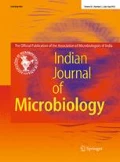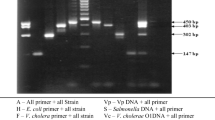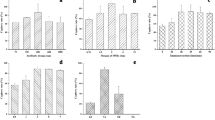Abstract
Glanders is highly contagious disease of equines, caused by Burkholderia mallei. The disease though rare, can be transmitted to humans. Here, we report a strategy for rapid detection of B. mallei from environmental samples. Different bacteriological media were evaluated and brain heart infusion broth medium with selective supplements (BHIB-SS) of penicillin (200 U/ml) and crystal violet (1:10,00000) was found to support the maximum growth of B. mallei even in the presence of other bacteria like Escherichia coli and Staphylococcus aureus. A polymerase chain reaction (PCR) and a DNA hybridization method was standardized for 823 bp specific dNA sequence of B. mallei. To enable the quicker and direct enrichment of B. mallei bacteria from environmental samples, an immunomagnetic separation (IMS) method was also standardized. Water, husk, grass and gram samples were artificially contaminated by B. mallei bacteria and after enrichment of B. mallei in BHIB-SS, detection was carried out by PCR and DNA hybridization. PCR was found to be a better method of the two with a detection limit of 104–106 CFU/ml (6 h enrichment in BHIB-SS) in water and other particulate matrices. Detection by PCR in the above samples without enrichment in BHIBSS was carried out following IMS where the detection limit was about 1–2 log higher than PCR following enrichment in BHIB-SS. We recommend PCR for 823 bp for detection of B. mallei from environmental samples either following enrichment in BHIB-SS or IMS. IMS-PCR method may be preferred in situations where numbers of B. mallei bacteria are expected to be high and results are required in short time.
Similar content being viewed by others
References
Fritz DL, Vogel P, Brown DR, Deshazer D and Wagg DM (2000) Mouse model for sublethal and lethal intraperitoneal glanders (B. mallei). Vet Pathol 37:626–636
Quinn PJ, Markey BK, Carter ME, Donnelly WTC and Leonard FC (Eds.) (2002) Veterinary Microbiology and Microbial Disease. Blackwell Science Publication, Oxford, UK, pp 237–251
Srinivasan A, Kraus CN, DeShazer D, Becker PM, Dick JD, Spacek L, Bartlett JG, Byrne WR and Thomas DL (2001) Glanders in a military research microbiologist. N Engl J Med 345:256–258
van Zijderveld FG and Bongers J (2000) Glanders. In: Manual for Standards for Diagnostic Tests and Vaccines. 4th edition, Office International des Epizootics, Paris, pp 576–591
Arun S, Neubauer H, Gurel A, Ayyildiz G, Kuscu B, Yesildere T, Meyet H and Hermanns W (1999) Equine glanders in Turkey. Vet Rec 144:255–258
Krishna L, Gupta VK and Masand MR (1992) Pathomorphological study of possible glanders in solipeds in Himachal Pradesh. Ind Vet J 69:211–214
Muhammad G, Khan MZ and Athar M (1998) Clinicomicrobiological and therapeutic aspects of glanders in equines. J Equine Sci 9:93–96
Sanford JP (1995) Pseudomonas species (including malioidosis and glanders). In: Principles and Practice of Infectious Diseases. 4th edition, Mandell GL, Bennett JE, Dolin R (Eds.), Churchill Livingstone, New York, pp 2003–2009
Heine HS, England MJ, Wagg DM and Byrne WR (2001) In vitro antibiotic susceptibilities of Burkholderia mallei (causative agent of glanders) determined by broth microdilution and E-test. Antimicrob Agents Chemother 45:2119–2121
Wheelis M (1998) First shots fired in biological warfare. Nature 395:213
Verma RD and Mishra VC (1989) Research on epizootic diagnosis and control of glanders with a view to eradicate the disease from India. Project closure reported submitted ICAR, Ministry of Agriculture, Govt. of India, New Delhi, pp 1–54
Hutyra F, Marek J and Manninger R (1949) Special pathology and therapeutics of the diseases of domestic animals. 5th Eng Edn. Vol 1. Balliere Tindall and Cox, London, pp 722–773
Boyden SV (1950) Absorption by erythrocytes of antigens of Pf. mallei and Pf. whitmori. Proc Sac Exp Biol Med 73: 289–291
Sen GP, Singh G and Joshi TP (1968) Comparative efficacy of serological tests in the diagnosis of glanders. Ind Vet J 45:286–292
Jana AM, Gupta AK, Pandya G, Verma RD and Rao KM (1982) Rapid diagnosis of glanders in equines by counterimmuno-electrophoresis. Ind Vet J 59:5–9
Howe C and Miller WR (1947) Human glanders: report of six cases. Ann Intern Med 26:93–115
Palermo D, Puccini V and Sobrero L (1974) Experimental studies of glanderd diagnosis. I. Identification of Actinobacillus mallei by immunofluoresence. Acta Med Vet Napoli 20:177–181
Verma RD, Sharma JK, Venkateswaran KS and Batra HV (1990) Development of an avidin-biotin dot enzymelinked immunosorbent assay and its comparision with other serological tests for diagnosis of glanders in equines. Vet Microbial 25:77–85
Tomaso H, Scholz HC, Al Dahouk S, Pitt TL, Treu TM and Neubauer H (2004) Development of 5′ nuclease real-time PCR assays for the rapid identification of the Burkholderia mallei/Burkholderia pseudomallei complex. Diagn Mol Pathol 13:247–253
Scholz HC, Joseph M, Tomaso H, Al Dahouk S, Witte A, Kinne J, Hagen RM, Wernery U and Neubauer H (2006) Detection of the reemerging agent Burkholderia mallei in a recent outbreak of glanders in United Arab Emirates by a newly developed fliP-based polymerase chain reaction assay. Diag Microbiol Infect Dis 54:241–247
Kumar S, Balakrishna K, Singh GP and Batra HV (2005) Rapid detection of Salmonella typhi in foods by combination of immunomagnetic separation and Polymerase chain reaction. World J Microbiol Biotechnol 21:625–628
Bergeron MG, Boissinot M, Huletsky A, Menard C, Ovellette M, Picard FJ and Roy PH (2002) Highly conserved genes and their use to generate probes and primers for detection of microorganisms. Patent no:WO/2001/023604
Lowry OH, Rosebrough NJ, Farr AL and Randall RJ (1951) Protein measurement with the folin phenol reagent. J Biol Chem 193:265–275
Gupta SK (1993) Antisera — techniques of immunization, use of adjuvants. In: A Hand Book of Practical Immunology. Talwar GP (Ed.), Vikas Publishing House Pvt. Ltd., New Delhi, pp 32–48
Batra HV, Chand P, Ganju L, Mukherjee R and Sadana JR (1989) Dot-ELISA for the detection of antibodies in bovine brucellosis. Res Vet Sci 46:143–146
Author information
Authors and Affiliations
Corresponding author
Rights and permissions
About this article
Cite this article
Merwyn, S., Kumar, S., Agarwal, G.S. et al. Evaluation of PCR, DNA hybridization and immunomagnetic separation — PCR for detection of Burkholderia mallei in artificially inoculated environmental samples. Indian J Microbiol 50, 172–178 (2010). https://doi.org/10.1007/s12088-010-0003-3
Received:
Accepted:
Published:
Issue Date:
DOI: https://doi.org/10.1007/s12088-010-0003-3




